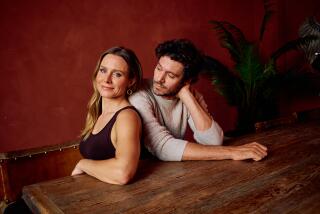Showbiz’s newest dynamic duo
Shepard Fairey enjoys reaching out to people whose work he admires. When he also forms a personal bond with the person he has approached, he says it feels like “things in the universe are in their correct place.” Which is why the rebellious street artist who skyrocketed to international fame in 2008 with his ubiquitous Obama “Hope” poster is particularly tickled about his budding friendship with actor/comedian/provocateur Russell Brand.
Fairey traffics in the iconography of fame, and Brand, in his just-released memoir “Booky Wook 2,” is obsessed with fame’s machinations and implications. It’s little wonder then that the two men are on the same creative wavelength, but what is striking is the speed with which their personal relationship has developed and the depth of their creative collaboration.
Since they first met at the 2010 Art of Elysium gala, which Fairey designed, they have teamed up on the jacket cover for “Booky Wook 2”; the “Just Say Yes” video in the film “Get Him to the Greek,” starring Brand; and a forthcoming documentary Brand is working on that Fairey loosely calls “the Big I Am.”
Call it an iconoclastic bromance, one that was cemented further when the pair discovered that they were neighbors in Los Feliz.
“We’re both very busy but we try to make quality time for each other,” said Fairey in a three-way call with Brand, who was doing a book tour in the UK.
“We’re expecting the baby any day,” joked Brand, adding: “Now I hang out with his daughters and his wife.”
“We had Russell over for dinner and our 5-year-old daughter, Vivienne, asked, ‘Is jokes your job?’” recalled Fairey.
“I said, ‘Your dad just does drawings for a living. He’s a scribbler,’” said Brand.
Despite the men’s easygoing banter, their relationship represents something deeper. Their personal histories are steeped in counterculture rebellion and they have long aimed their artistic arrows at the heart of America’s consumer-capitalist society. The problem is that now that the rebels are the ultimate celebrity insiders, it has become increasingly difficult to rage against the machine.
Together, they have found solidarity and created a fresh quiver of anti-authority symbols to draw from.
“I think the common ground they found is in the conflict of their success,” wrote Jack Bayles, a producer of Brand’s forthcoming documentary, in an e-mail from the UK. “I can’t speak for Shepard but I know that Russell has started to grasp some of the more negative consequences of realizing his dream and is now looking to expand his work beyond some of the more immediate rewards of fame and wealth.”
That’s where Fairey comes in. As an artist he has long espoused what he calls an inside-outside strategy of subversion. Since the late 1980s his brand of guerrilla pop art has sought to take the relevant signifiers of mainstream marketing and branding and deploy them as unsettling outsider-art doppelgängers. His first coup was his “Andre the Giant has a Posse” campaign that appeared to be selling something, but was in fact selling nothing more than its own ubiquity.
When Fairey first approached Brand he offered to provide him with visual art for anything that he happened to be working on.
“It was the opening of a favor floodgate,” said Brand, who became well-known for his rampant drug use and sex addition (which he catalogs in his first memoir, “My Booky Wook”), before cleaning up his act and fine-tuning his still-hedonistic approach to life and humor. “He gave me an inch, I gave him a marathon.”
The jacket cover for “Booky Wook 2” was among the initial favors. It is embossed with gold lettering and features Brand with smoke coming out of his heavily jeweled fingers. The words “Heaven” and “Hell” are reflected in his sunglasses, as if the letters themselves are written on L.A.’s famous Hollywood sign.
Another project that Fairey and Brand worked on together was a pop-up shop in the Beverly Center called “the Free Store.” It contained among other things Fairey’s art, some of Brand’s personal belongings and a dress from Brand’s pop-star fiancée, Katy Perry. People were encouraged to trade an unwanted item of their own for an item in the store.
Fairey designed the shop’s marketing campaign, a process he explained at length over a Diet Coke in his bustling Echo Park studio. “Marketing promises things it can’t deliver; it’s more of an aspirational idea than a tangible reality,” he said. “So I made some posters that said in very small type ‘You can not’ and then in big type, ‘Buy Love Here,’ and then in small type ‘But you can trade it for the best material substitute.’ It all looked sort of like bold advertising or government warning signs.”
Scenes from that experiment will be used in Brand’s documentary and Fairey’s signs, and others like them, might end up being used as the marketing campaign when the film comes out, added Fairey.
The Free Store helped the men realize the full potential of their partnership as they bonded over the nature of charity and selfishness and the limitations of Marxist philosophy. They were thrilled when people made fair trades and angered when people took advantage by leaving pieces of crumpled paper and taking pieces of Fairey’s art.
“At the Beverly Center we used the landscape of consumer culture to present an alternative to these corporate ideas,” said Brand.
“In the documentary I think he’ll use that to show that a sense of entitlement is pretty pervasive in the culture, but certainly not everyone is like that,” said Fairey. “And he’ll use humor so it doesn’t seem preachy.”
More to Read
The biggest entertainment stories
Get our big stories about Hollywood, film, television, music, arts, culture and more right in your inbox as soon as they publish.
You may occasionally receive promotional content from the Los Angeles Times.











